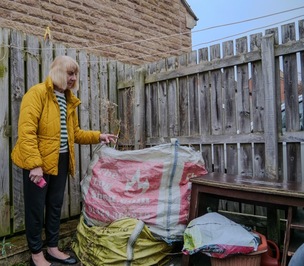A FAMILY say they would finally have ‘closure’ if the remains of a local war hero airman shot down more than 80 years ago are finally discovered in a huge salvage mission set to be conducted overseas.
Sergeant Alfred Mortimer, who was from Thurnscoe, lost his life on June 26, 1943, near the town of Holwert in the north of the Netherlands.
It is believed his plane, a Wellington bomber, crashed off the Friesland coast into the Wadden Sea after being intercepted by a German night fighter ace and that all of the five-man crew, including navigator Alfred, 31, were killed and subsequently listed as ‘missing in action’.
The day after the crash only a few pieces of the wreck were found and the plane had sank into the mud. The wreckage was too deep to be recovered as it laid under a sea dike.
But now the Chronicle can reveal a salvage mission is being planned and is due to be led by the Royal Netherlands Airforce.
Work is expected to begin in late July and will take a month.
Sgt Mortimer’s niece, Carolyn Bell, was contacted by the organisation, Stichting Missing Airmen Memorial Foundation (SMAMF), who are also involved with the recovery mission and are liasing with the families of the missing men.
Carolyn, 68, who lives in Elsecar, said: “I know that my mum was hit very, very hard by his death and always wanted his name reading out on Armistice Day.
“This will give us closure for her even though she’s sadly not around to know about it.
“It would be nice to give him a proper burial.
“My daughter did a school project about Alfred but sadly that got lost and we don’t have anything about him.
“They have offered to take us over later in the year but I am disabled so I’m not sure it’s going to be possible.
“It is quite a fascinating story really as a family we are really interested in it.”
SMAMF’s secretary Alexander Tuinhout said: “We finally have an opportunity to salvage the Wellington, because new works on the dike have to be done.
“The Dutch government adopted the national programme for aircraft recovery in 2018 which gives the opportunity to municipalities to have the last Second World War wrecks salvaged (only when the presence of human remains is suspected).
“Every year about four to five wrecks German, British and American are being excavated.
“An important player is the salvage officer of the Royal Netherlands Air Force and his team, who have much expertise about raising plane wrecks.”
Alfred was born in January 1912 and his home address was Shepherd Lane, Thurnscoe, with his wife Clara, a school teacher at The Hill school.
He was the son of Herbert and Lily Mortimer of Chapel Street, also in Thurnscoe.
Previously a repair man, he had completed his flight training in Canada after signing up in September 1941.
He and the rest of the crew, pilot Charles Mattress, bomb aimer Sgt John Priestley, wireless operator Sgt Norman Ronald Perry and rear gunner Sgt Tom Ball are featured on the Runnymede Memorial in Surrey and there is also a monument to the crew at Waddenzeedijk.
Part of 166 Squadron, the crew of the HE346 left RAF Kirmington, now Humberside Airport, and were on a mission to bomb the city of Gelsenkirchen in the Battle of the Ruhr, the intended destruction of the German industrial heartland.
The crew were approaching the West Frisian Islands and would have been heading across the North Sea home before they were fatally intercepted.
The crash site was officially identified in the early 1990s when a ring with one of the men’s initials on was unearthed by a metal detectorist and subsequently identified by his widow.
Eternal gratitude of the Dutch people
THE eternal gratitude of the Dutch people is the driving force behind honouring the fallen, like Thurnscoe’s own war hero Alfred Mortimer.
After laying in the Wadden Sea for more than eight decades a painstaking and costly salvage operation will be launched this summer to recover the remains of the navigator, his crewmates and their plane, a Wellington bomber which was shot down in June 1943.
Alexander Tuinhout, secretary of the organisation helping the project alongside the Royal Dutch Air Force, said the liberty of their country is never taken for granted even to this day.
He told the Chronicle: “Our Stichting Missing Airmen Memorial Foundation is an official part of the salvage team and does the historical research, including writing a booklet for the general public.
“We have done this kind of work since the 1970s and have searched through many hundreds of metres of archives since.
“We also trace family members of the missing crewmen in order to obtain more information and to invite them for a commemoration ceremony which in this case will be held in August.
“For us, it’s very important to tell the story of the young men who risked and sometimes gave their lives for our freedom and to pass on the message that freedom is not for free.
“Even after more than 80 years it is still important to give missing airmen a decent burial; this means a lot to their families, to people from the local community and to our foundation.
“Hopefully Alfred can be given a final resting place as well later this year.
“The aircraft salvages always include an educational programme for schoolchildren and more and more young people attend the annual commemorations of war victims every year.
“For the HE346 crew a commemoration will be held as well, which will hopefully be attended by family-members of the crew. Bringing them together and giving them an opportunity to exchange stories about the lost crewmen is one of the main goals of our foundation.
Dilip Sarkar MBE has worked alongside similar recoveries with the Dutch army and is a leading Second World War aviation author.
He told the Chronicle: “The Dutch feel a debt of honour to those who died effecting their liberation and are very proactive about it.
“It will be a huge engineering feat with the water being pumped out and then the painstaking work begins. It is a hell of an operation to return someone to their family is a massive deal.
“I believe that losses reverberate down the generations. I cannot imagine the courage needed to go into what would have then been a primitive plane, with no lights on the ground, to bomb at night. The family should be rightly proud.”
Dilip says flying across this region of occupied Netherlands would have been ‘prime hunting ground’ for the elite Nazi airmen.
Records show that the pilot responsible for shooting down the British crew was Rudolf Sigmund who himself died in action in October of the same year.
It seemed as though the plane would be lost forever but clues kept emerging.
Alexander added: “The fate of the HE346 has been unknown for a very long time. A German report about the crash mentions that the aircraft was brought down near the village of Makkum, which is many miles further to the south.
“Most likely the village of Marrum is meant, which is close to the crash site. During some works on the sea dike in 1977 parts of the characteristic geodetical frame of the Wellington were found, which confirmed that the unknown plane must have been a Wellington.
“In 1991, and by coincidence, fellow researchers found a silver signet ring with the initials ‘J.P.’ and in the municipal archives also a clue was found which pointed in the direction of the plane’s bomb-aimer John Peter Priestley.
“His widow confirmed that the ring had belonged to her husband, which was the first step in the identification of the aircraft. A monument was also raised in the early 1990s.”





























